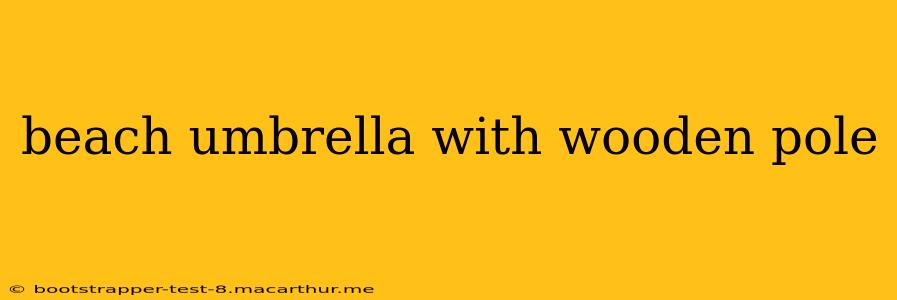The sun's rays can be intense on the beach, making a sturdy and stylish beach umbrella a necessity for a comfortable day by the sea. While many umbrellas rely on aluminum or steel poles, the classic charm and natural beauty of a wooden pole beach umbrella offer a unique appeal. This guide explores the benefits, considerations, and care required for this increasingly popular choice.
Why Choose a Wooden Pole Beach Umbrella?
The allure of a wooden pole beach umbrella extends beyond its aesthetic qualities. Here's why many beachgoers opt for this timeless design:
-
Aesthetic Appeal: Wooden poles offer a natural, elegant look that complements various beach settings and personal styles. They often add a touch of rustic charm or sophisticated elegance, depending on the wood type and finish.
-
Durability (When Properly Treated): High-quality wood, when properly treated against water damage and UV rays, can be surprisingly durable. It can withstand the elements better than some cheaper aluminum counterparts.
-
Weight and Stability: Wood offers a natural weight that can contribute to greater stability, especially in windy conditions, providing more secure shade. However, this can also make transportation slightly more challenging.
-
Sustainability: Choosing sustainably sourced wood for your beach umbrella supports environmentally conscious practices.
What Types of Wood are Used?
Several types of wood are used in constructing beach umbrella poles, each with its unique properties:
-
Hardwoods: Hardwoods like teak or acacia are known for their durability, resistance to rot, and weather resistance. They are often a premium choice, reflecting in the higher price point.
-
Softwoods: While less durable than hardwoods, treated softwoods can still provide adequate protection and a more budget-friendly option. However, they require more diligent care and may not last as long.
How to Choose the Right Wooden Pole Beach Umbrella?
Selecting the perfect wooden pole beach umbrella involves careful consideration of several factors:
-
Size: Consider the size of your group and the amount of shade needed. Larger umbrellas provide more coverage but may be more challenging to manage in windy conditions.
-
UV Protection: Look for umbrellas with a high UPF rating (Ultraviolet Protection Factor) to ensure adequate sun protection.
-
Wind Resistance: Features like vents or reinforced construction can significantly improve wind resistance, preventing damage or accidental collapses.
-
Weight and Portability: While wood adds stability, it also adds weight. Consider how easily you can transport and set up the umbrella.
What is the best wood for a beach umbrella pole?
Teak and acacia are generally considered the best woods due to their natural resistance to rot and water damage. However, properly treated other hardwoods or even softwoods can also be suitable options depending on your budget and intended use.
Are wooden beach umbrellas difficult to transport?
Yes, wooden beach umbrellas are generally heavier than those with aluminum poles, making transportation somewhat more challenging. However, many models come with convenient carrying bags or straps to alleviate this.
How do I maintain a wooden beach umbrella?
Regular cleaning and proper storage are essential to prolong the life of your wooden beach umbrella. Rinse the umbrella with fresh water after each use, allow it to dry completely, and store it in a cool, dry place during off-season. Regular application of a suitable wood sealant or protective oil can further extend its lifespan.
Conclusion
A beach umbrella with a wooden pole offers a unique blend of style, durability, and natural beauty. By carefully considering the factors discussed above and following proper care instructions, you can enjoy years of shade and elegance on the beach. Remember to choose a reputable supplier to ensure quality materials and construction.
